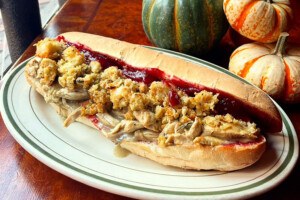10 Trends for the Philly Food Scene in 2017
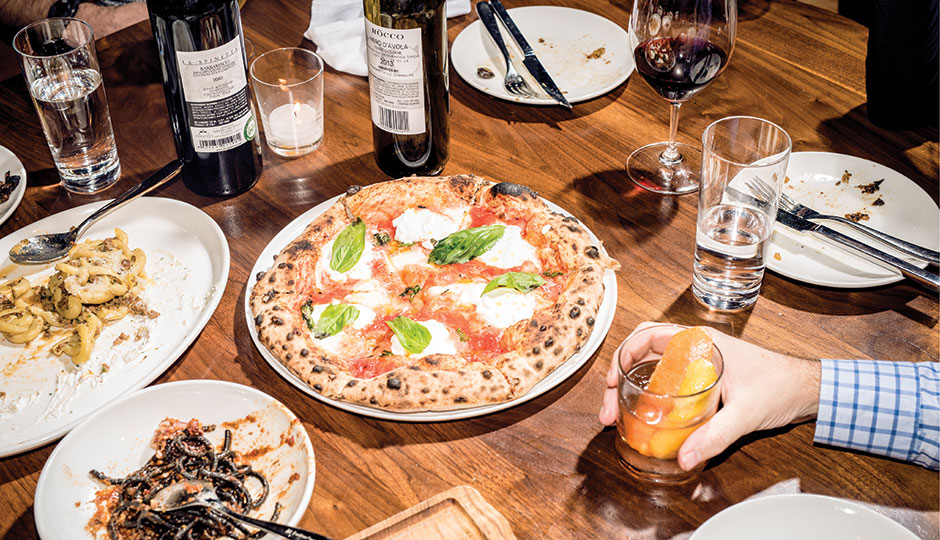
Pizza, pasta and booze at Wm. Mulherin’s Sons in Fishtown | Photograph by Christopher Leaman
We’ve reached a major point in the evolution of our food scene: the top. Pretty much every eatery and drinkery that opens in Philly these days — or ticks off another year of being in the biz — is really damn good. And really-damn-good as our baseline opens up a whole new world of epicurean pleasures. In 2017, we’ll dig in. How? Chefs are now waking up before sunrise to make sure your breakfast is as good as your dinner. Local distillers are serving you that glass of small-batch whiskey anywhere you want (even in Suburban Station). Restaurateurs are crafting neighborhood pizza joints with pies even Neapolitans would love. It’s good to be a hungry Philadelphian in 2017. Let’s eat.
1. Restaurants go viral
Technology makes us rethink eating out.

DanDan Noodles at DanDan in Rittenhouse | Photograph by Christopher Leaman
When Jim Lord opened Grubhouse in South Philly in 2013, he knew the success of his breakfast/lunch cafe depended on neighborhood foot traffic. And almost right away, weekend business was swift. But Lord eventually had to scale back his hours — he just wasn’t seeing the revenue he needed to justify staying open during the workweek. Then came the Philadelphia launches of Caviar and UberEATS, app-based restaurant-delivery services that get food from restaurants to customers very quickly. Now Grubhouse’s weekday sales have doubled and on some days tripled, and Lord is boxing up so many orders that he’s back to being open six days a week.
Such high-tech delivery services fulfill every local restaurant owner’s dream of selling lots of food with minimal expense. Caviar, which launched here in 2014, now has more than 300 restaurants signed on and just launched service on the Main Line. The company works with restaurants to determine which menu items can be delivered the quickest, takes magazine-worthy photos of each dish, and sets up the technology. It taps freelance drivers and bicyclists to get food to people fast, often in 30 minutes. Philadelphians, on their end, are loving home delivery: no need to make reservations, find parking or even put on pants. Dishes from top eateries—jalapeño bucatini from Amis in Midtown Village, maybe?—reach your South Philly home in a flash. This kind of delivery is an easy habit to fall into, even with fees that can add an extra $8 or so to your order.
Which raises the question: Do restaurants even need storefronts anymore? What are the chances such apps will do to eating out what e-commerce has done to brick-and-mortar shopping? Bill Hanson, owner of MilkBoy, says online orders typically come from customers who’ve dined at his spots in the past; indeed, the top orders from Caviar are from some of Philly’s most beloved restaurants. Still, on UberEATS you can order a crab fried rice bowl from Savage Product, a provider that doesn’t appear to have a tangible location—or even Yelp reviews. But when you want wings at 2 a.m., does it matter that they’re coming from someplace you’ve never been in?
Next up for Grubhouse: experimenting with dinner service — a far less scary proposition now that delivery can boost a slow start-up even when no one walks in the door. (Arthur Etchells)
2. Vegan mania continues
Meat eaters, join or die. (But seriously, just join. You won’t be disappointed.)
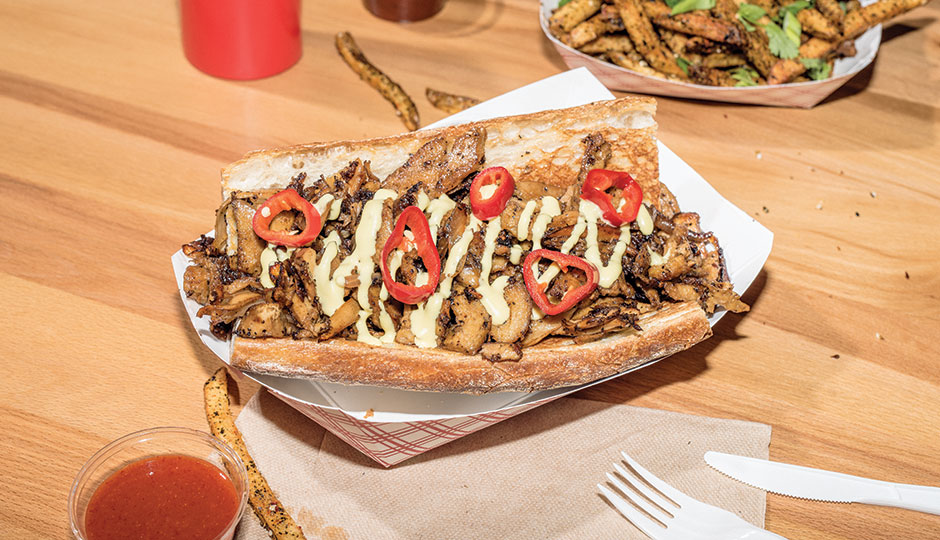
The Wiz Kid Philly, a vegan cheesesteak, from Wiz Kid | Photograph by Christopher Leaman
Got an out-of-town vegan friend who’s popped in for a visit? No need to place a frantic call to Vedge begging for a table; appropriate eateries continue to sprout up all over town. At Fishtown’s Front Street Cafe, everything on the menu is plant-based unless it’s accompanied by a pig or cheese symbol (see what they did there?); Heart Beet Kitchen in Westmont has butternut squash bruschetta and roasted potato pizza (and pop-up yoga classes); South Philly’s The Tasty has all-vegan diner food; and for something sweet, Dottie’s Donuts in West Philly has fluffy rounds (think strawberry powdered sugar and coconut cream) sans animal products. Or you could hit up Wiz Kid, Rich Landau and Kate Jacoby’s less buttoned-up concept that recently opened in the new Pennsylvania Avenue Whole Foods (with a second Rittenhouse location coming soon). Their signature sandwich takes on a daring task: remaking the cheesesteak. (Adjua Fisher)
3. Eating in Center City is boring
These vanguard restaurant owners are defying the Rittenhouse rule by opening destination-worthy spots in your backyard.

The restaurateurs dine at Kensington Quarters in Fishtown | Photograph by Christopher Leaman
Shawn Darragh and Ben Puchowitz, owners of Cheu Noodle Bar, Bing Bing Dim Sum, and soon-to-open Cheu Fishtown and Nunu Bar.
Neighborhood takeovers: East Passyunk, Washington Square West, Fairmount
and Fishtown.
Why Shawn loves their ’hoods: “When we first tried to open, we wanted the foot traffic of Rittenhouse, but the rent just didn’t make sense. We were nervous when we were opening Bing Bing, but people come two, three times a week. If we run out of eggs, we can walk across the street to Townsend and borrow some. My employees hang out with our regulars, and all the restaurant owners are really close.”
Justin Weathers and Joseph Monnich, owners of Stove & Tap and soon-to-open Al Pastor and Bella Vista.
Neighborhood takeovers: Lansdale and Exton
Why Justin loves their ’hoods: “There’s so much opportunity in the suburban market, and to bring something good to a community is amazing—the excitement level is much higher. People appreciate good food, and there’s a high demand for great service and great atmosphere. We really can connect with the community.”
Michael and jeniphur Pasquarello, owners of Café Lift, Bufad, Prohibition Taproom and Kensington Quarters.
Neighborhood takeovers: Callowhill and Fishtown
Why Michael loves their ’hoods: “Jen and I stumbled across the Café Lift space, but our passion for the neighborhood grew, and the people were so supportive. That’s why we did the next two restaurants. We are lucky—we’re going to get that viaduct we’ve been waiting for. I haven’t ever considered Rittenhouse or Old City, but I wouldn’t rule them out. I’m not scared of the rent; I just like the ways the communities in the smaller neighborhoods work together.”
Kelly and Sean Weinberg, owners of Restaurant Alba and Biga.
Neighborhood takeovers: Malvern and Bryn Mawr
Why Sean loves their ’hoods: “We like the demographic of the people here. We get college students, empty nesters, young Main Line families, people that lived in the city but moved out. There’s this myth that you have to dumb things down for the suburbs, but we feel the total opposite — people have a good palate and are well cultured. We try to be honest, and they respond to that.”
4. Say bye-bye to burrata
Five ingredients and dishes you’ll see all over menus in 2017

Shishito peppers at Royal Sushi & Izakaya in Queen Village | Photograph by Christopher Leaman
Shishito peppers
After years of making guest appearances on menus, these sorta-spicy Asian peppers have moved up to headlining star. At Double Knot they’re served with Sapporo chicken, at both locations of Helm they’ve shared a plate with tomatoes and mussels, and at the new Royal Sushi & Izakaya in Queen Village, they come skewered, blistered and snackable.
Snails
Last year’s mini-boom in French restaurants in Philly (and a global retrenchment of French technique) is paying dividends on menus. To wit: The parsley cavatelli with escargots and bone marrow at Fairmount’s A Mano and the two different versions at Good King Tavern.
Colatura
There’s almost nothing in any international canon that doesn’t have a corollary in Italian cuisine. Take, for instance, colatura, an Italian anchovy sauce danking up menus across the city (see: the pork ribs at Wm. Mulherin’s Sons) that’s essentially an ancient Roman version of Vietnamese nuoc cham.
Yogurt
Yogurt has long been used as a way to smooth out or cool down spice. But Philly’s chefs have reimagined it—as in the green yogurt that dresses the meatballs at Harp & Crown, or at Aldine, where it’s mixed with smoked apples and mustard seed to top pork.
Chicken wings
The purists who believe wings should wear nothing but Frank’s RedHot and butter might want to stop reading. Local chefs have turned the humble wing into a palette for experimentation. In fact, Sidecar Bar & Grille hosts wing takeovers at which chefs like Nick Elmi, Adan Trinidad and Luke Palladino have cured wings in coffee, tossed them in black garlic mole and stuffed them with foie gras mousse.
5. You can basically drink anywhere now.
Tasting rooms in train stations, rum in coffee shops, wine-by-the-glass in supermarkets—boozehounds, it’s your year.

The Federal Distilling Tasting Room in Kensington | Photograph by Christopher Leaman
Lawmakers in Harrisburg seem half in the bag these days, and we’re okay with that. The changes started in 2011, when legislation was passed to allow small-batch distilling (which hadn’t been legal since Prohibition). There were four small distilleries in the Commonwealth then; now there are more than 50, with five—including Rowhouse Spirits, New Liberty Distillery and Red Brick Craft Distillery — in one square mile around Fishtown. The hits keep coming: Restaurants, hotels, convenience stores and food markets can now sell wine; grocery stores can serve it; six-packs can be had at beer distributors; distillers can sell their products directly to consumers. It’s not quite privatization, but things have really been shaken up. Most importantly: Philadelphians suddenly have lots more places to get drunk.
Many local spirit makers — like Federal Distilling in the city and Bluebird Distilling in Phoenixville — now have full-fledged (and often gorgeous) cocktail bars. Philadelphia Distilling, the trailblazer known for Bluecoat Gin, is relocating to the Fillmore music hall and will open its first consumer-facing bar soon. Those distilling licenses also come with the right to open five remote tasting rooms. That’s how Manatawny Still Works, which is located in Pottstown, plans to co-opt the Philadelphia drinker — they’re opening pint-size tasting rooms on East Passyunk Avenue and in Suburban Station soon. Coffeemaker La Colombe makes (and so can serve) rum in its Fishtown flagship. All breweries can now serve spirits and wines without an additional liquor license as long as they’re locally made, which is why you can order cocktails at brewpubs like Brewerytown’s Crime & Punishment and Kensington’s Saint Benjamin.
Possibly, though, the biggest change is that we can now drink where we buy milk. Wegmans has had sorta-separate pubs for years, but even the Acme in Paoli has gotten into the bar game. The new downtown Whole Foods was the first city market to embrace this opportunity, building a subway-tiled bar with taps just feet from the salad bar. (There’s also a roaming cocktail cart.) And here’s something that’s not often associated with Whole Foods: fair pricing. The grocer is selling beers for $3 that cost more than $9 at other bottle shops. (Arthur Etchells)
6. Spirits get serious.
The region’s legion of fledgling distillers are poised to go beyond basic.
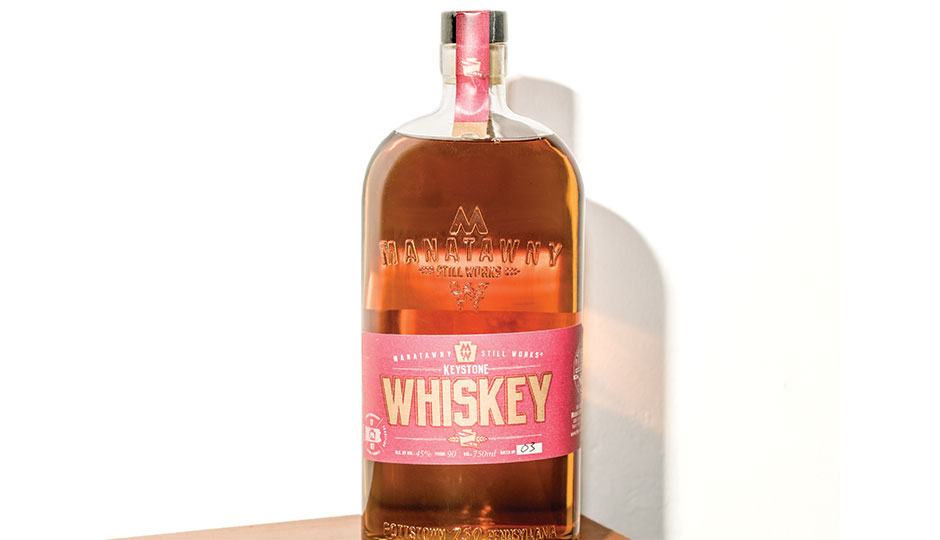
Photograph by Christopher Leaman
New Liberty Distillery, Kensington
Master distiller Rob Cassell is kicking production into overdrive and says he’ll release a new spirit every 30 to 60 days this year. One example: Pennsylvania Dutch Malt Whiskey, which he’s been aging for two years.
Dad’s Hat Rye, Bristol
Newly added equipment and personnel mean production here can more than double; look for Straight Rye, a three-year-minimum-aged product, to hit state stores this winter.
Philadelphia Distilling, Fishtown
The makers of Bluecoat Gin are moving (and growing) this year, opening in the new Fillmore music complex. (That concert just got way more fun, huh?) Fresh release: Tough Broad, a whiskey-beer collaboration with Yards Brewing.
Red Brick Craft Distillery, Kensington
Seek out From the Woods, a birch-beer-like liqueur made from fermented brown sugar and honey steeped with black birch twigs.
Rowhouse Spirits Distillery, Kensington
Expect three different brandies made with local fruit and some less traditional Scandinavian-inspired akvavits.
Manatawny Still Works, Pottstown
Debuting in 2017 is Pennsylvania Whiskey, a flagship product made with malt, oats, wheat and rye. Two-plus years in the barrel equals dense flavors and a mellow burn.
7. Restaurants stay open all day.
Why shouldn’t we be able to get great food whenever we want it?

Scenes from Hungry Pigeon throughout the day | Photograph by Christopher Leaman
Res Ipsa is a restaurant of the moment—a minimalist Rittenhouse cafe that’s open all day. A collaboration between a serious culinary crew (the owners of Stock in Fishtown) and a bunch of coffee aficionados (the owners of ReAnimator Coffee in Kensington), it offers breakfast sandwiches when the sun is up and hand-rolled pasta when the sun is down. In Fishtown, Front Street Cafe has fresh juices and an outdoor bar and is closed for only a handful of hours a day. At Cornerstone in Wayne, people perch at the chef’s counter for French toast at 8 a.m., for a tasting menu at 7 p.m., and for wine and cheese in between. Before them, it was Double Knot and Hungry Pigeon, which serve both morning meals and dinners by candlelight. And even before them, it was High Street on Market, Parc, A.Kitchen and Talula’s Daily — early pioneers that changed the essential utility of a restaurant and made us feel just a little more European.
Once upon a time, the local diner was the center of the community—a place you dropped into at any hour for coffee, pancakes, meatloaf, and the company of your neighbors. The coffee shop replaced the diner, and the upgraded coffee shop (like the new La Colombe in Bryn Mawr and MilkBoy, which opens at 7 a.m. and closes at 2 a.m. and serves coffee and Citywide Specials) replaced the standard coffee shop.
This is the way Philly wants to eat now. Maybe it’s because we’re desperate for something cozy after spending our days in sterile open offices, or maybe it’s because the hours of our lives no longer accommodate standard meal periods. At this new breed of cafe, the lighting feels right at 7 a.m. and 7 p.m., and the servers will never drop the bill to keep the tables turning. These places that are sort of everything — sort of a coffee shop, a bit like a diner — are mostly comfortable transitional restaurants focusing equal and loving attention on everything we want right now. (Jason Sheehan)
8. The world comes to Philly.
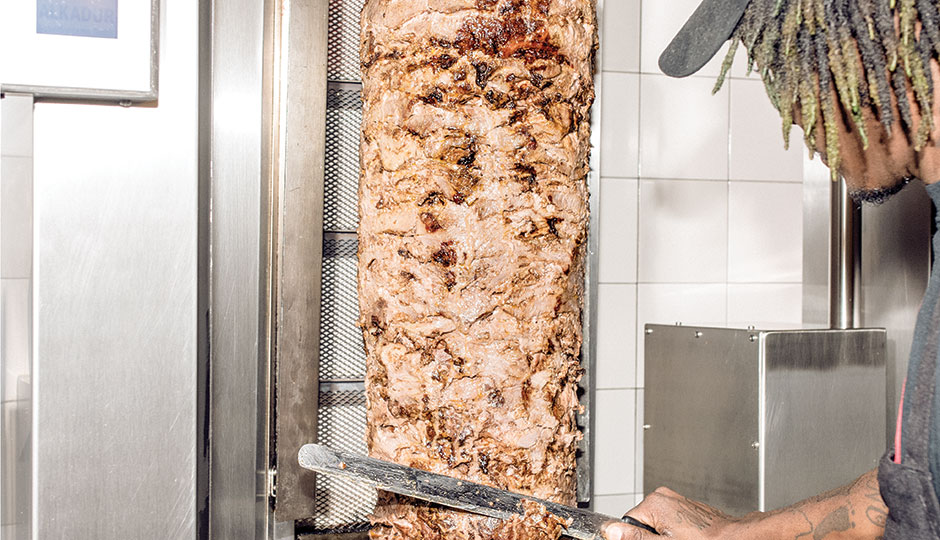
Shawarma at Naf Naf Grill in Center City | Photograph by Christopher Leaman
Thank you, millennials! Because of your influx, the tastiest, hippest chains are clamoring to open shop here.
Philadelphians care about food,” says Snap Kitchen CEO David Kirchhoff. “The city is pumping with energy. When I listen to people talk about Philly, it reminds me of how people talked about Austin back in the day.” Austin? While you might be tempted to insert a self-deprecating Philly joke here, he’s right: Our market is suddenly more appealing than ever thanks to our love of food, our walkability, our 20-somethings and our affordable rents. The coolest fast-casual and upscale concepts are taking note. In fact, Snap Kitchen and Naf Naf Grill are choosing to break into the East Coast market through Philly, not New York, Boston or D.C. Here, the new kids in town:
1. Snap Kitchen
From: Austin, TX
What: Daily-prepped healthy takeout
Where: Six in greater Center City, plus up and down the Main Line and more on the way. First East Coast locations.
2. Melt Shop
From: NYC
What: Grilled cheese
Where: King of Prussia. Second out-of-NYC location.
3. The Halal Guys
From: NYC
What: Gyros and chicken that started as a food cart
Where: King of Prussia, Chinatown
4. &pizza
From: Washington, D.C.
What: Personal, customizable pizzas
Where: Center City. First out-of-D.C. location.
5. Sweetgreen
From: Washington, D.C.
What: Tossed-to-order salads
Where: Philly (Center City, Rittenhouse and University City), King of Prussia, Ardmore
6. Founding Farmers
From: Washington, D.C.
What: Large, upscale farm-to-table restaurant
Where: King of Prussia. First out-of-D.C. location.
7. Naf Naf Grill
From: Chicago
What: Falafel, pitas, shawarma
Where: Center City, KOP, South Jersey. First East Coast locations.
8. Scarpetta
From: NYC
What: Upscale Italian
Where: Rittenhouse
9. P.J. Clarke’s
From: NYC
What: Storied New York bar and restaurant
Where: Washington Square. Second out-of-NYC domestic location.
9. Breakfast Is the New Brunch
These restaurants are ensuring Tuesday breakfast is the most memorable meal of your week.
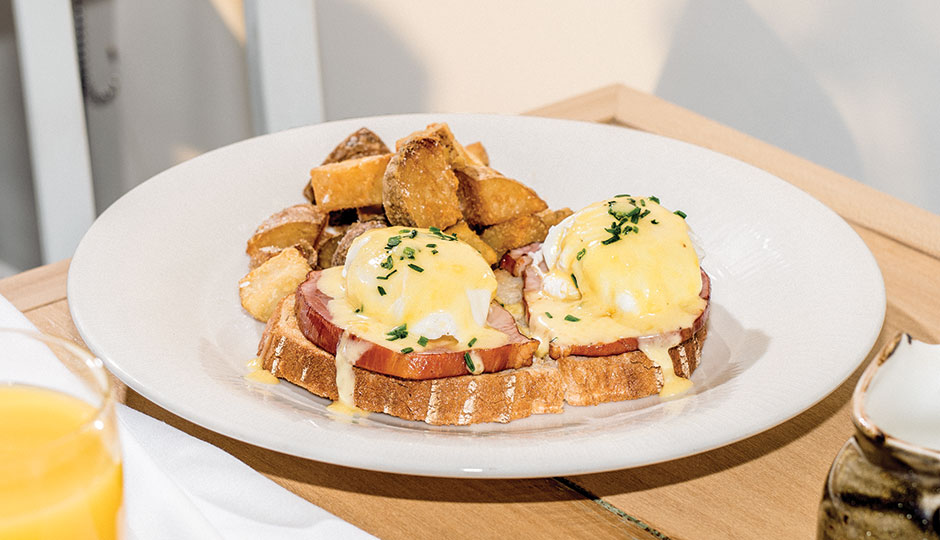
Eggs Benedict at Avenue Kitchen in Villanova | Photography by Christopher Leaman
First Watch, Villanova and Wynnewood
Whether it’s a “power breakfast quinoa bowl” or “chile chorizo omelet” kind of day, Main Liners love this chain, as evidenced by the mega lines on weekend mornings.
Plenty Café, multiple locations
Decisions, decisions: Which of the draft coffees will pair best with your pancetta-hash-and-egg sandwich?
Avenue Kitchen, Villanova and Glen Mills
Breakfast meetings on the Main Line used to mean grabbing a table at a down-home diner. With this elevated duo of sunup-to-sundown eateries, morning sessions can have a bit more elegance, plus quinoa hash browns and a fried egg.
Turning Point, multiple locations
This Jersey-born chain has remade the diner with an updated Shore-pancake-house vibe, a massive coffee and tea program, and a two-page menu for gluten-shunners.
Hungry Pigeon, Queen Village
If you can resist the glistening banana bread sticky buns, puffy biscuits and curvaceous almond croissants piled high on the counter at this all-day eatery, you’ll be rewarded with the stuff coming from the hot line: an egg sandwich on a house-baked English muffin, a kimchi spicy breakfast bowl …
Girard Bruncherie, Fishtown
This BYOB got a bunch of initial press for its unconventional no-tipping policy. Rebranded as a daytime cafe, it’s serving up avocado toast with crab and thick-cut French toast. Get there before 9 a.m. and get two eggs any style with potatoes and toast for just $5.
The Dutch, Pennsport
This is what happens when two chefs show off their late-night omelet prowess. Joncarl Lachman (of Noord and Neuf) and Lee Styer (of Fond) now offer those perfect omelets to the public at a sunny cafe that’s open most mornings.
10. Chefs get healthy.
And so do their menus.
Who: Natalie Maronski, executive chef, Lou Bird’s, Rittenhouse
Obsessed with her health since: “Forever. I was diagnosed with rheumatoid arthritis when I was a kid, so I was encouraged to stay active to make sure I stayed healthy.”
How she cooks: “Nothing is too heavy. It’s all a focus on lighter food, with flavor from acid rather than butter or cream.”
Favorite healthier menu item right now: “Pan-seared striped bass with a hearty farro salad, roasted beet puree and braised fennel.”
Most surprising thing she consumes: “Pedialyte, to make sure I’m hydrated.”
Who: Jeff Michaud, chef/executive culinary director, Vetri Family.
Fitness regime: “I do jiu-jitsu four to five times a week in King of Prussia for about two hours each session.”
How he eats: “I lived in Italy for three years, and my wife is Italian. She cooks a lot at home. Italians use healthy ingredients and serve the right portion sizes. It’s this farm-to-table thing that everyone’s using in the States now—Italians have been doing it forever.”
Favorite healthier menu item right now: “At Osteria we have a beautiful antipasti board, all veggies that are in season, marinated and cooked with very light dressings.”
Who: Scott Schroeder, chef/co-owner, Hungry Pigeon, Queen Village
How he eats: “Two years ago, I was eating vegan almost every day, to kick-start a healthier lifestyle. I still try to eat very healthy—the bulk of my diet is still vegan or vegetarian—but I’m not as strict about it.”
Obsessed with his health for: Seven years.
How he cooks: “Just because you’re in a restaurant doesn’t mean everything has to be decadent and meat-driven. Our focus is on using super-nice ingredients with flavors that can stand on their own, so I’m able to use less butter, more olive oil; more lemon juice, less salt.
Who: Brett Naylor, executive chef, Oyster House, and co-owner, Mission Taqueria, both in Center City
Why his health matters: “I stopped drinking and started getting into fitness, and that has really transformed how much I appreciate my body and respect myself.”
His fitness regime: “I’m an avid biker. Next summer I’m doing my first Half Ironman, in the Finger Lakes.”
How he cooks: “We use a lot of grains and all fresh fish—wild-caught East Coast seafood—and fresh produce simply prepared. Let the ingredients speak for themselves.”
How the industry has health-ified: “There’s a place and a need for those rich, heavy restaurants and classic French cuisine, but I think more diners want fresher, simpler food. That’s why you see a lot of California cuisine around here and in New York.”
Who: Yehuda Sichel, executive chef, Abe Fisher, Rittenhouse
Obsessed with his health for: Five years.
His fitness regime: “I do CrossFit a few times a week and jiu-jitsu four times a week.”
How he eats: “Paleo, so it’s mostly meat and veggies. I’ve found it’s actually pretty easy to do. But I don’t restrict myself from tasting anything at my restaurants, since it’s part of my job.”
How he cooks: “Since I care about where my food comes from, I feel weird about, say, serving chicken that’s not organic or treated nicely. Most of our produce comes from local farmers, and that’s really important to me. You can taste the difference.” (Emily Leaman)
Published as “Where to Eat 2017” in the January 2017 issue of Philadelphia magazine.

